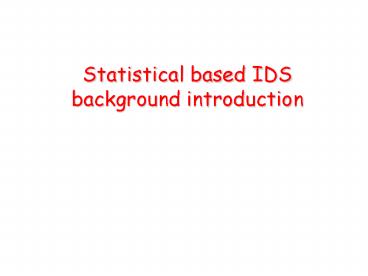Statistical based IDS background introduction - PowerPoint PPT Presentation
Title:
Statistical based IDS background introduction
Description:
Internet has various network attacks, including denial of service ... 2. unsurprised data training and surprised data training. 3. high accuracy - Disadvantage ... – PowerPoint PPT presentation
Number of Views:22
Avg rating:3.0/5.0
Title: Statistical based IDS background introduction
1
Statistical based IDS background introduction
2
Statistical IDS background
- Why do we do this project
- Attack introduction
- IDS architecture
- Data description
- Feature extraction
- Statistical method introduction
- Result analysis
3
Project goals
- Related work
- Internet has various network attacks, including
denial of service attacks and port scans, etc. - Overall traffic detection
- Flow-level detection
- Our goals
- Detect both attacks at the same time
- Differentiate DoS and port scans
4
Attack introduction
- TCP SYN flooding
- - An important form of DoS attacks
- - Exploit the TCPs three-way handshake
mechanism and its limitation in maintaining
half-open connection - - Feature spoofed source IP
- - Recent reflected SYN/ACK flooding attacks
5
Attack introduction
- Port scan
- - horizontal scan
- - Vertical scan
- - Block scan
- Feature real source IP address
6
Statistical IDS architecture
- Learning part
- Detection part
7
Data description
- DARPA98 data
- The first standard corpora for evaluation of
network intrusion detection systems. - From the Information Systems Technology Group (
IST ) of MIT Lincoln Laboratory, - Under Defense Advanced Research Projects Agency (
DARPA ITO ) and Air Force Research Laboratory (
AFRL/SNHS ) sponsorship - Seven weeks of training data
- Two weeks of detection data
8
Data description
- DARPA98 data format
- 897048008.080700 172.16.114.169.1024 gt
195.73.151.50.25 S ACK 10553301111055330111(0)
win 512 ltmss 1460gt - - Time stamp 897048008.080700
- - Source IP address port 172.16.114.169.1024
- - Destination IP address port
195.73.151.50.25 - - TCP flag S (maybe other R, F, P)
- - ACK flag ACK
- - Other part of packet header
- 10553301111055330111(0) win 512 ltmss 1460gt
9
Feature extraction
- Calculate the metrics in every 5 minute traffic
- Metrics
- For example
- SYN-SYN_ACK pair
- SYN-FIN SYN-RSTactive pair
- traffic volume
- SYN packet volume
- Good Luck ?
10
Statistical method
- Statistical based IDS
- Goals Using statistical metrics and algorithm
to differentiate the anomaly traffic from benign
traffic, and to differentiate different types of
attacks. - - Advantage detect unknown attacks
- - Disadvantage false positive and false
negative
11
Hidden Markov Model (HMM)
- HMM is a very useful statistical learning model.
It has been successfully implemented in the
speech recognition. - - Advantage
- 1. analyzing sequence data (using observation
probability and transition probability to
represent) - 2. unsurprised data training and surprised data
training - 3. high accuracy
- - Disadvantage
- comparatively long training time
12
Double Gaussian model
- Introduction
- - Two Gaussion distribution models are used to
represent two classes of behaviors - - Get the two probabilities of current behavior
using different two-class Gaussian parameters - - Compare them. The current behavior belongs to
the larger probability class. - Training period
- - Get the two-class Gaussian parameters
- Detection period
- - Use two-class Gaussian parameters to get
probabilities and compare them
13
Double Gaussian model
- Advantage
- Simple, easy to understand
- Fast
- Disadvantage
- No sequence characteristic
14
Result analysis
- Evaluation
- - Important quantitative analysis
- false positive false negative
- - Looking at metric value, and finding the
reasons - - Repeating experiments































